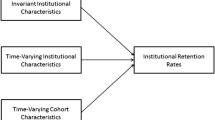Abstract
This study empirically explores the comparability of traditional survey-based retention research methodology with an alternative approach that relies on data commonly available in institutional student databases. Drawing on Tinto’s [Tinto, V. (1993). Leaving College: Rethinking the Causes and Cures of Student Attrition (2nd Ed.), The University of Chicago Press, Chicago.] theory of student integration, this project utilizes an information-theoretic approach [Burnham, K.P., and Anderson, D. R. (2002). Model Selection and Inference: A Practical Information-theoretical Approach (2nd ed.), Springer-Verlag, New York, NY.], in which a set of candidate models was developed using institutional integration survey variables and variables drawn from institutional student databases. An information-theoretic approach to selecting the most parsimonious logistic regression model revealed that institutional database variables out-perform the institutional integration survey scales developed by Pascarella and Terenzini [Pascarella, E. T., and Terenzini, P. T. (1980). Journal of Higher Education 51(1): 60–75.] in predicting 1-year retention. This empirical support for the use of institutional database variables is valuable in conducting institution-specific retention research under constrained resources.
Similar content being viewed by others
References
Akaike, H. (1973). Information theory as an extension of the maximum likelihood principle. In: Petrov, B. N., and Csaki, F. (eds), Second International Symposium on Information Theory. Akademiai Kiado, Budapest.
Akaike H. (1974). A new look at the statistical model identification. IEEE Transactions on Automatic Control AC 19:716–723
Antley, H.W. (1999). The development of a predictive model for one-year freshman retention rate: A macro-approach. A Paper Presented at the 39th Annual Forum of the Association for Institutional Research, Seattle, WA.
Astin A. W. (1984). Student Involvement: A developmental theory for higher education. Journal of College Student Personnel 25:297–308
Bean J. P. (1985). Interaction effects based on class level in an explanatory model of college student dropout syndrome. American Educational Research Journal 22(1):35–64
Berger J. B., Braxton J. M. (1998). Revising Tinto’s interactionalist theory of student departure through theory elaboration: Examining the role of organizational attributes in the persistence process. Research in Higher Education 39(2):103–119
Berger J. B., Milem J. F. (1999). The role of student involvement and perceptions of integration in a causal model of student persistence. Research in Higher Education 40(6):641–664
Burnham K. P., Anderson D. R. (2002). Model selection and inference: A Practical Information-Theoretical Approach (2nd ed.). Springer-Verlag, New York, NY
Cabrera A. F., Nora A., Castaneda M. A. (1993). College persistence: Structural equations modeling test of an integrated model of student retention. Journal of Higher Education 64(2):123–139
Durkheim, E. (1951). Suicide: A study in Sociology (J. A. Spaulding, G. Simpson, Trans.), The Free Press of Glenco, New York.
Horn, L.J., and Carroll, C.D. (1998). Stopouts or Stayouts? Undergraduates Who Leave College in Their First Year, (National Center for Education Statistics Statistical Analysis Report No. NCES 1999–087), US Department of Education Office of Educational Research and Improvement, Washington, DC.
Hosmer D. W., Lemeshow S. (2000). Applied Logistic Regression (2nd ed.). New York, John Wiley & Sons
Knight, W.E. (2002). Toward a comprehensive model of influences upon time to bachelor’s degree attainment (AIR Professional File No. 85), Association for Institutional Research, Tallahassee, FL.
Mallette B. I., Cabrera A. F. (1991). Determinants of withdrawal behavior: An exploratory study. Research in Higher Education 32(2):179–194
Nelson R. B, Scott T. B., Bryan W. A. (1984). Precollege characteristics and early college experiences as predictors of freshman year persistence. Journal of College Student Personnel 25:50–54
Pascarella E. T., Chapman D. (1983). A multi-institutional path analytical validation of Tinto’s model of college withdrawal. American Educational Research Journal 20:87–102
Pascarella E. T., Terenzini P. T. (1980). Predicting freshman persistence and voluntary dropout decisions from a theoretical model. Journal of Higher Education 51(1):60–75
Pascarella E. T., Terenzini P. T. (1983). Predicting voluntary freshman year persistence/withdrawal behavior in a residential university: A path analytic validation of Tinto’s model. Journal of Educational Psychology 75(2):215–226
Peng C. Y. J., So T. S. H., Stage F. K, St. John E. P. (2002). The use and interpretation of logistic regression in higher education journals: 1988–1999. Research in Higher Education 43(3):259–284
Porter, S.R. (1999). Viewing one-year retention as a continuum: The use of dichotomous logistic regression, ordered logit, and multinomial logit. A Paper Presented at the 39th Annual Forum of the Association for Institutional Research, Seattle, WA.
Porter, S.R. (2002). Including transfer-out behavior in retention models: Using the NSC EnrollmentSearch Data. AIR Professional File, 82.
Terenzini P. T., Pascarella E. T. (1980). Toward the validation of Tinto’s model of college student attrition: A review of recent studies. Research in Higher Education 12(3):271–282
Terenzini P. T., Lorang W. G., Pascarella E. T. (1981). Predicting freshman persistence and voluntary dropout decisions: A replication. Research in Higher Education 15(2): 109–127
Terkla D. G. (1985). Does financial aid enhance undergraduate persistence?. Journal of Student Financial Aid 15(3):11–18
Tinto V. (1975). Dropout from higher education: A theoretical synthesis of recent research. Review of Educational Research 45:89–125
Tinto V. (1982). Limits of theory and practice in student attrition. Journal of Higher Education 53:687–700
Tinto V. (1987). Leaving college: rethinking the causes and cures of student attrition. Chicago, The University of Chicago Press
Tinto V. (1993). Leaving college: rethinking the causes and cures of student attrition (2nd ed.). Chicago, The University of Chicago Press
Author information
Authors and Affiliations
Corresponding author
Rights and permissions
About this article
Cite this article
Caison, A.L. ANALYSIS OF INSTITUTIONALLY SPECIFIC RETENTION RESEARCH: A Comparison Between Survey and Institutional Database Methods. Res High Educ 48, 435–451 (2007). https://doi.org/10.1007/s11162-006-9032-5
Received:
Published:
Issue Date:
DOI: https://doi.org/10.1007/s11162-006-9032-5




